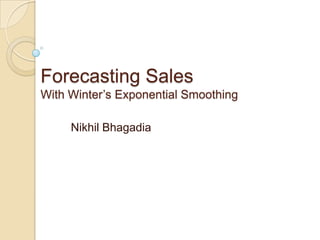
Forecasting sales
- 1. Forecasting Sales With Winter’s Exponential Smoothing Nikhil Bhagadia
- 2. Importance of Forecasting Sales : Forecasting is the process by which people ponder and prepare for the future. Marketing : Total demand for products must be forecasted in order to plan total promotional effort.
- 3. Types of Forecasting Techniques Qualitative Forecasting Methods These Methods are used when historical data are scarce or not available at all. Based more on expert opinion to predict future. Used in Sales of new product, etc. Quantitative Forecasting Methods These Methods are used when historical data are available. Advantage :- Reproducible by any forecaster Based on approved techniques and model available. Full proof and reliable.
- 5. What is a Time Series? A time series is a series of observations on a particular variable collected over a period of time (usually at equally spaced intervals). Time Series Components Trend Cyclical Seasonal Irregular
- 6. Cyclical Trend Component Component Overall upward or downward Upward or downward swing movement Data taken over a period of years Seasonal Irregular Component Component Upward or downward swing Erratic, nonsystematic, random, fluctuations Short duration and non- repeating
- 7. Winter’s Exponential Smoothing Winter’s exponential smoothing model is the second extension of the basic Exponential smoothing model. It is used for data that exhibit both trend and seasonality. It is a three parameter model that is an extension of Holt’s method. An additional equation adjusts the model for the seasonal component.
- 8. Winter’s Exponential Smoothing The four equations necessary for Winter’s multiplicative method are: The exponentially smoothed series: yt LEVEL Lt (1 )( L t 1 bt 1 ) St s The trend estimate: TREND bt ( Lt Lt 1 ) (1 ) bt 1 The seasonality estimate: SEASONALIT yt Y St (1 )St s Lt
- 9. Winter’s Exponential Smoothing ◦ Forecast m period into the future: Ft m ( Lt mb t ) S t m s Lt = level of series. = smoothing constant for the data. yt = new observation or actual value in period t. = smoothing constant for trend estimate. bt = trend estimate. = smoothing constant for seasonality estimate. St =seasonal component estimate. m = Number of periods in the forecast lead period. s = length of seasonality (number of periods in the season) Ft m = forecast for m periods into the future.
